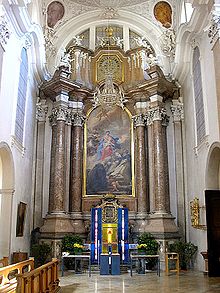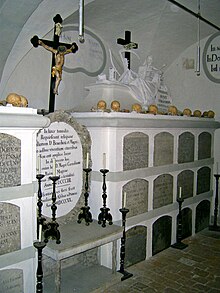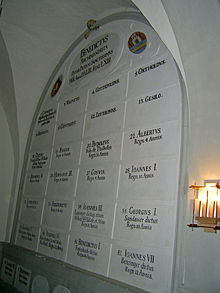Saint Mang monastery

The St. Mang's Abbey is a former convent of Benedictine in Fussen in Bavaria in the diocese of Augsburg .
history
The Benedictine monastery of St. Mang was built in the first half of the 9th century as the monastery of the bishops of Augsburg . The founding process goes back to the work of the hermit Magnus , who built a cell and an oratory here and died there on September 6th . The year of death itself is not known. The miraculous elevation of the unharmed body of Magnus, which proved his holiness, formed the spiritual basis of the monastery.
The founding of the abbey was not only religiously motivated, there were also tangible power-political interests in the background. Located on the Roman Via Claudia Augusta from Augsburg over the Alps to Northern Italy and on the Füssener Enge, the breakthrough of the Lech from the Alps , the monastery occupied a key geographical position. The Augsburg bishops and imperial politics endeavored to occupy this strategic point .
The history of the abbey in the Middle Ages was shaped by the efforts of the conventuals in the ups and downs of social developments to live a faithful life according to the rules of St. Benedict . Over the centuries, the monastic community has repeatedly joined reform movements aimed at returning to the roots of Benedictine life. Most of the reforms triggered a spiritual, personal and economic upswing , which was then also reflected in new building measures and art orders.
The counter-Reformation energy found its lasting expression in the construction of a mighty baroque monastery , which was built between 1696 and 1726. The St. Mang monastery complex, together with the High Castle, has a significant impact on the cityscape of Füssen today .
The aim of the building owner, Abbot Gerhard Oberleitner (r. 1696–1714) and his convent, who intended to “arouse the envy of all art lovers” with the new building was also to create extraordinary things.
The architect Johann Jakob Herkomer (1652–1717) succeeded in designing a representative, symmetrically arranged building complex from the irregularly grown medieval monastery. The transformation of the medieval basilica into a baroque church based on Venetian models was intended to become an architectural symbol of the veneration of St. Become Magnus. The church building represents a monumental reliquary of the saint. For the first time in the southern German baroque building, the life description of the local saint provides the pictorial program for the fresco cycle of the entire church here in St. Mang .
In the second half of the 18th century, however, the convent increasingly turned to social tasks: pastoral care, science, music and education. Although the abbey was never able to achieve the imperial immediacy it was striving for , it shaped Füssen and the entire region as a center of power and economy, as a cultural focal point and as the center of religious life.
On December 11, 1802, in the course of the Napoleonic Wars and the Peace of Lunéville, the Princely House of Oettingen-Wallerstein took possession of the St. Mang monastery and its lands, as well as the Maihingen monastery . On January 15, 1803, Princess Wilhelmine ordered Abbot Aemilian Hafner to dissolve the convent and to vacate the monastery by March 1, 1803. In 1819, Franz Xaver Seelos, who was beatified in 2000, was baptized in the monastery church. In 1821 Prince Ludwig von Oettingen-Wallerstein also bought the nearby Hohenschwangau Castle in order to save it from the impending demolition, but sold it again in 1823; It was not restored until 1832 by Crown Prince Maximilian , for whom the Hohe Schloss Füssen , located above the St. Mang Monastery and the former summer residence of the Augsburg prince-bishops, was originally intended as a summer residence.
In 1839, the royal Bavarian treasurer Christoph Friedrich Freiherr von Ponickau bought the rule of St. Mang. But first, in 1837, was the former monastery church in an endowment to the "cult" of the parish feet transmitted. Since then, the former Benedictine abbey has been divided between two owners.
In 1909 the city of Füssen acquired the ponickausche estate of St. Mang and with it the former monastery building. She set up her town hall here in the north wing . In the south wing there is now the museum of the city of Füssen, in which the baroque representative rooms of the monastery can also be visited.

The organ was built in 1753 by organ builder Andreas Jäger . In 1877 the instrument was almost completely rebuilt by organ builder Balthasar Pröbstl . In 1958 and 1978 the organ was rebuilt and restored by the Zeilhuber Orgelbau company. The instrument has 37 stops (cone chests) on three manual works and a pedal . The playing and stop actions are electric.
|
|
|
|
|||||||||||||||||||||||||||||||||||||||||||||||||||||||||||||||||||||||||||||||||||||||||||||||||||||||||||||||||||||||||||||||
St. Anne's Chapel
The original chapel was built in the 9th century as the first monastery church of the St. Mang Abbey and later served primarily as a burial place for the Knights Freyberg-Eisenberg . Today it is part of the city museum in the monastery building and can be visited.
In 1602 Jakob Hiebeler created the famous monumental Füssen dance of death on behalf of Abbot Matthias Schober for the St. Anna Chapel , which is one of the most important representations of its kind in the German-speaking world. Under the motto “Says Yes, Says No, Danced Muess Sein”, various social role models of early modern society follow on twenty individual pictures (on ten wooden panels), led by Pope and Emperor Death. The depiction of the witch as one of four female figures is famous. In addition to numerous epitaphs and death shields from the 16th and 17th centuries, the late Gothic sculpture of " Anna selbdritt " can be admired.
Baroque building
Imperial Hall
- Architect: Carlo Andrea Maini
- Fresco: Franz Georg Hermann (1692–1768)
- Completion: 1721–1723
The ballroom of the abbey was designed by master builder Johann Jakob Herkomer (1652–1717) as the center of the entire monastery complex. At the same time, the hall lies on the central axis of the monastery church and the monastery entrance. The architecture and artistic furnishings as a colonnade hall had the political function of demonstrating the grandeur of the abbey.
The polarity of church and world is also the theme of the magnificent ceiling frescoes created by the later court painter Franz Georg Hermann (1692–1768) from Kempten . The building owner Abbot Dominikus Dierling entrusted the planning of the interior architecture to the architect Carlo Andrea Maini from Arogno , who also designed the Kaisersaal in Ottobeuren . With the architectural concept of Maini, the Abbey of St. Mang joined the monastery and palace buildings that imitated the "imperial style of Charles VI." With this splendid rectangular hall, the monastery demonstrated its endeavors to achieve the status of imperial immediacy.
At the same time, the ceiling paintings illustrate the outstanding role of the Benedictine order in church history. The entire concept of the equipment of the ballroom is subject to a sophisticated number symbolism . The series of numbers 2 - 4 - 8 - 16 - 32 pervades this entire structure, with the number 4 already dominating as a symbol for "world" given by the rectangular floor plan. In the ceiling painting, "Church" and "World" face each other. The church is symbolized by 4 stucco figures, which represent the cardinal virtues and each have an attribute with them: Cleverness has a mirror, bravery the sword, justice the scales and temperance the unicorn. The world is also symbolized by 4 stucco figures, which stand for the four continents Africa, Europe, Asia and America; Australia and the Antarctic were still unknown at the time. Eight presented columns and 16 pilasters structure the wall development and a 32-point compass rose centers the ceiling painting.
The Imperial Hall, which is also known as the Prince's Hall, can be viewed today as part of the Füssen City Museum and serves as a chamber music hall for the “Prince's Hall Concerts”, which have been held every year between June and September since 1951.
Library and refectory
- Architect: Johann Jakob Herkomer (1652–1717)
- Fresco: Francesco Bernardini
- Sculptor: Anton Sturm (1690–1757)
- Oil painting: Franz Anton Zeiler (1716–1794)
- Completion: 1719
The library building in St. Mang is considered the most original in Bavarian Swabia .
The unusual oval structure of the library forms the center of the southern front of the baroque complex, the castle-like face of the monastery. The interior is surprising both because of its high overhang and especially because of the large oval opening in the middle of the room, which allows a view down into the refectory , the monks' dining room.
This architectural concept is to be understood as a symbolic sign and symbolizes the unity of mind and body, of mental and physical nourishment. Travelers reported that music was played from above the library at banquets. Towards the end of the 18th century there was even a jukebox in the library.
In winter, the breakthrough could be closed with a lid made of an oil painting because of the extreme cold. The painting was created by Franz Anton Zeiler in 1781 and shows the triumphal chariot of the founder of the order, Benedict , being pulled from the four continents.
In summer the monks had a high view from the refectory up to the dome fresco by Francesco Bernardini from 1719, which shows four female figures as allegories of divine wisdom , prudence , truth and knowledge . The putti by sculptor Anton Sturm on the library gallery ask how the other frescoed ceilings, the various liberal arts shows.
The sculpture, St. Depicting Magnus standing on the fountain in the refectory.
In the course of secularization after 1803, the entire book inventory was delivered to the new lords, the Princely House of Oettingen-Wallerstein, packed in boxes and barrels on rafts.
Today, most of the library holdings of the former St. Mang monastery, as part of the Oettingen-Wallerstein library, are located in the Augsburg University Library . A small, valuable part of the manuscripts was donated to the Augsburg Diocesan Archives.
Abbots of St. Mang
Up to the year 919 there is no documented mention of an abbot of the St. Mang monastery. According to the monastery tradition, St. Magnus was revered as the founding abbot, followed by Blessed Conrad.
| Dept | Regency | date of death |
|---|---|---|
| 1. S. Magnus | † September 6th | |
| 2. Konrad I. | ||
| 3. Wolpoto | 9th century? | † 26th of April |
| 4. Bernold | 9th century? | |
| 5. Leutolph | 9th century? | |
| 6. Gisilo | urk. 919 | |
| 7. Ortolf | † April 5 | |
| 8. Henry I. | ||
| 9. Gotebold | ||
| 10. Berthold | † August 23 | |
| 11. Adalbert | ||
| 12. Wilhelm | c. 1030-1040 | |
| 13. Eberhard | c. 1060-1061 | † May 11, 1091 |
| 14. Swidker | ||
| 15. Adalhalm | 1086 | † August 25, 1094 |
| 16. Alberich | † January 23 | |
| 17. Conrad II. | urk. 1160-c.1175 | |
| 18. Heinrich II. | urk. 1178 - 1191 | † 19th of February |
| 19. Conrad III. urk. 1206 & 1218 | † July 14th c. 1218 | |
| 20. Dieto (Theodo) | urk. 1219 & 1222 | † March 1225 |
| 21. Rugger | urk. 1227 | |
| 22. Rudolf von Thalhofen | urk. 1235, 1251 | † May 22 |
| 23. Albert | urk. 1255 | † March 13, 1256 |
| 24. Hermann I. | urk. 1257, 1262 | |
| 25. Hiltebold | urk. 1263, 1283 | † October 19, 1284 |
| 26. Conrad IV. | urk. 1284, 1285 | |
| 27. Hermann II. | urk. 1287, 1295, 1311 | |
| 28. Goswin | urk. 1313, 1317 | † July 8, around 1318 |
| 29. Henry III, | urk. 1319, 1335 | † December around 1336 |
| 30. Ulrich Denklinger | urk. 1336, 1339 | † January 18, 1347 |
| 31. John I. Hochschlitz | c. 1347 | † August 11 |
| 32. Luiprand | urk. 1374 | |
| 33. Friedrich | urk. 1390 | † April 28 |
| 34. John II Lauginger | urk. 1392, 1396 | † March 21, 1403 |
| 35. Georg I. Sandauer | 1397-1410 | † February 15, 1410 |
| 36. Yban von Rotenstein | 1410-1426 | † May 19, 1439 |
| 37. John III. Loaf | 1426-1431 | † May 16, 1431 |
| 38. Konrad V. Klammer | 1431-1433 | † March 13, 1433 |
| 39. John IV. Fischer | urk. 1436-res. 1458 | † March 30, 1460 |
| 40. Johannes V. Hess | 1458-res. 1480 | † 1481 |
| 41. Benedict I. Furtenbach | 1480-res. 1524 | † March 1531 |
| 42. John Baptist VI. Benzinger | 1524-1533 | † April 8, 1537 |
| 43. Gregor Gerhoch | 1537-1554 | † October 4, 1554 |
| 44. Sympert Lechler | 1554-res. 1556 | † November 21, 1560 |
| 45. George II Albrecht | 1556-1560 | † February 2, 1560 |
| 46. John VII Kessler | 1560-1567 | † June 8, 1567 |
| 47. Hieronymus Alber | 1567-1573 | † August 17, 1573 |
| 48. Matthias Schober | 1579-1604 | † August 15, 1604 |
| 49. Henry IV. Amman | 1604-1611 | † July 30, 1615 |
| 50. Martin Stempfle | 1614-res. 1661 | † February 26, 1665 |
| 51. Benedict II Bauer | 1661-res. 1696 | † July 26, 1696 |
| 52. Gerhard I. Oberleitner | 1696-1714 | † March 20, 1714 |
| 53. Dominikus Dierling | 1714-1738 | † September 4, 1738 |
| 54. Benedict III. Pautner | 1738-1745 | † January 18, 1745 |
| 55. Leopold Freiherr von Rost | 1745-1750 | † November 7, 1750 |
| 56. Gallus Zeiler | 1750-1755 | † January 7, 1755 |
| 57. Placidus Zerle | 1755-res. 1763 | † June 24, 1770 |
| 58. Gerhard II. Ott | 1763-1778 | † March 1, 1778 |
| 59. Aemilian Hafner | 1778-1803 | † May 19, 1823 |
museum
Today, the monastery houses the museum of the city of Füssen with the following focuses:
- History of the St. Mang Monastery
- History of lute and violin making in Füssen
- City history
literature
- Joseph Maria Helmschrott: Directory of old print monuments in the library of the ancient Benedictine monastery at H. Mang in Füeßen . Ulm 1790 ( digitized version )
- Pirmin Lindner: Monasticon Episcopatus Augustani antiqui . Bregenz 1913
- Rudibert Ettelt: History of the City of Füssen . Fuessen 1971
- David Leistle: The Aebte of St. Magnus in Füssen . In: Studies and communications on the history of the Benedictine order and its branches . 1918-1920
- Wolfgang Wüst: Spiritual state and old empire: Early modern forms of rule, administration and court keeping in the Augsburg prince diocese (studies on the Bavarian constitutional and social history XIX / 1 and XIX / 2) ed. vd Commission for Bavarian State History, Munich 2001, there on St. Mang in particular pp. 124–127. ISBN 3-7696-9709-X
- Thomas Riedmiller: The former Benedictine monastery Sankt Mang in Füssen . In: Werner Schiedermair (Ed.): Klosterland Bavarian Swabia. Lindenberg 2003, ISBN 3-89870-127-1
- Franz Matsche: The ballroom in the St. Mang monastery in Füssen as an imperial and imperial hall . In: Alt Füssen. Yearbook of the historical association Alt Füssen 2005 . Füssen 2006. ISSN 0939-2467 .
- Petra Hauke: Domus sapientiae. A contribution to the iconology of library interior design of the 17th / 18th centuries. Century with special consideration of the monastery St. Mang, Füssen . Bad Honnef 2007. ISBN 978-3-88347-258-4 .
- Klaus Wankmiller: Giovanni Antonio Pellegrini (1675-1741). A Venetian painted altar leaves for Füssen and Pfronten , in: Alt Füssen - Yearbook of the Historical Association of Alt Füssen (2011), pp. 18–55.
- Wolfgang Wüst: Füssen. In: Michael Kaufmann / Helmut Flachenecker / Wolfgang Wüst / Manfred Heim (eds.): The Benedictine monastery and nunnery in Bavaria (Germania Benedictina). Sankt Ottilien 2014, Vol. 1, ISBN 978-3-8306-7657-7 , pp. 681–708, exclusively regarding St. Mang.
- Thomas Riedmiller on behalf of the city of Füssen, Füssener Totentanz. Kempten 2014.
- Klaus Wankmiller: The confessional reliefs in the former Benedictine monastery church St. Mang in Füssen , in: Alt Füssen - Yearbook of the Historical Association of Alt Füssen (2015), pp. 5–23.
Individual evidence
Web links
- Monasteries in Bavaria: Kloster Sankt Mang (House of Bavarian History)
- Page about the Sankt Mang church on the homepage of the parish community in Füssen
- Photos of artwork in the church and monastery, in the Warburg Institute Iconographic Database .
Coordinates: 47 ° 33 '59.7 " N , 10 ° 41' 58.2" E








